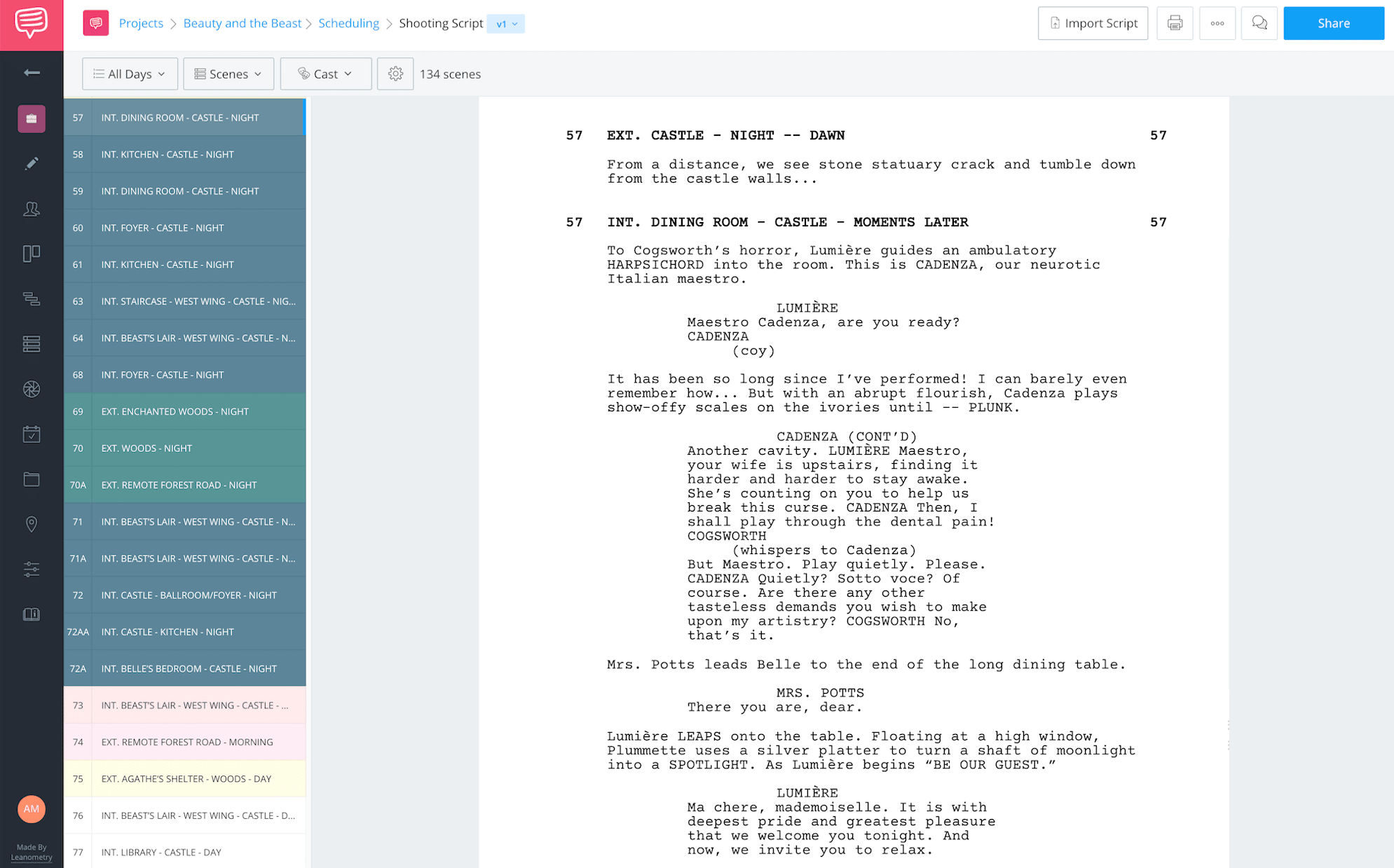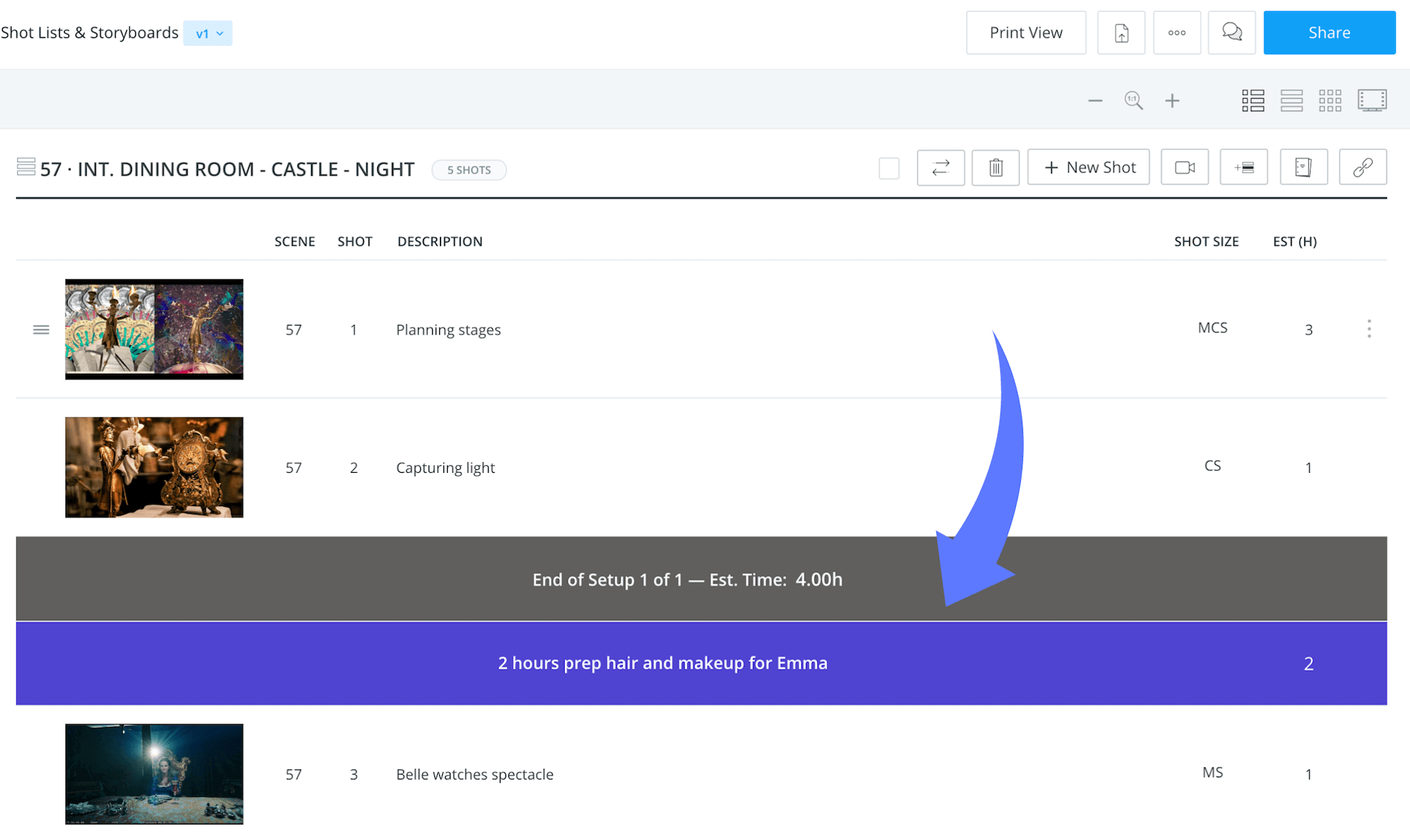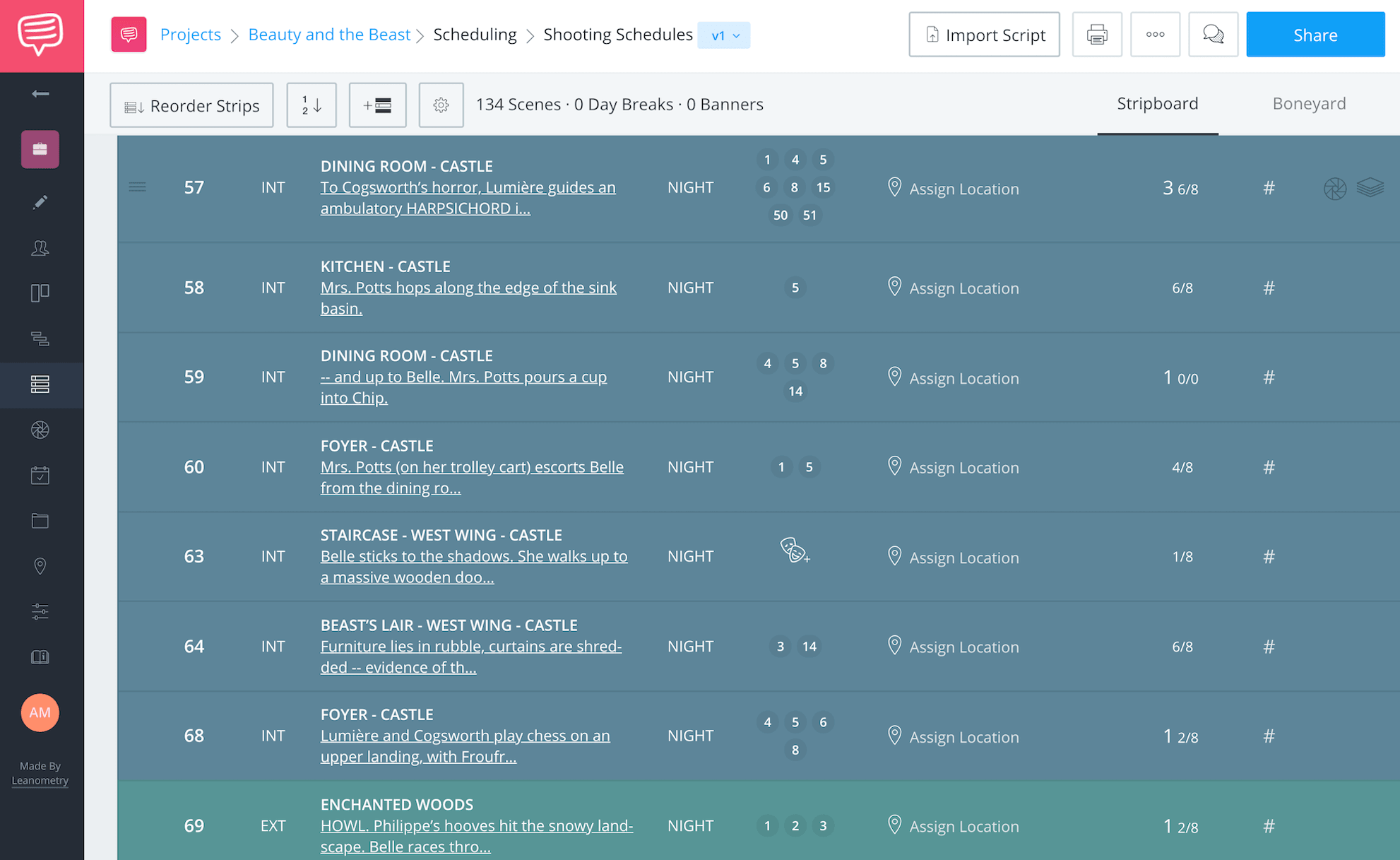Scheduling your film shoot is one of the very first steps in making your project come to life. But in order to schedule, it is our job to figure out how long it will all take – from the length of individual days to the length of the entire project.
There is a way to approach scheduling that will help ensure that the work you do isn’t in vain. Let’s take a look at a few tips and rules for estimating your prep and shoot times that you want to know for your next project. Let’s put some scheduling tips into practical use so that you are armed, and ready to shoot.
Script Breakdowns
1. Break down the scene
There are a ton of moving parts when figuring out how long it will take to plan your movie. If you’re a first assistant director, or producer, you know this well. You’ll get handed a script and know it’s time to break it down. If you’re not familiar with script breakdowns, it’s okay!
Breaking down a script simply means identifying everything needed to make that scene happen – things like props, cast, costumes, extras, visual effects, stunts, music, you name it. These are the scene elements, and if you can figure out what elements you need, you can figure out how to schedule them. You can identify and tag these elements fairly easy in StudioBinder:
So let’s jump into a movie that would be both fun and challenging to breakdown.
Let’s consider Beauty and The Beast, the 2017 live action remake of the classic Disney film. First of all, it is a musical. Musicals require many elements most films don’t - singing and dancing demands choreography, and rehearsals.
Let’s take a look at the scene first.
This particular musical also requires a ton of visual effects, because well, most of the characters are inanimate objects.
This film in particular also has extensive set dressings, props, hair, make-up, and costumes. And all of these elements must be highlighted and tagged. Let’s take a look at Scene 57, the iconic musical number, “Be Our Guest.”
So, you get the shooting script and it looks like this:
Yikes. Where do you start? It’s a bit overwhelming.
But it doesn’t have to be. Once the script is imported in StudioBinder, we can begin to break it down.
We can go line by line, tagging anything that we will need to schedule.
When we begin to break it down, it looks like this:
Notice the drag and drop menu making it a cinch to highlight and tag what you need. First things first, who is in the scene? We can highlight and tag, “Belle,” “Lumière,” “Mrs. Potts,” as "cast members."
And as we read, we realize the lines of dialogue are actually lyrics in the song. So we can tag those as “music.”
You can also tag “sound” because as previously mentioned, many of these characters are animated and will need voice overs.
This is a very well known musical number, so this song is already figured out. But for other projects, I like to involve my composer early on in the process. If I have a line that reads “plays a dramatic scale” like in this one, I would invite my composer to the project, and ask him or her to provide samples of what that would actually sound like.
Is it in line with my vision? Do I even need it there at all?
In this case, the music here is already realized, and has been for many years, so just tagging “music” is sufficient.
The next element we should consider in a musical is dancing. While it may be a little challenging to determine every dance move, some things stand out. When Belle dances, we can tag this as “choreography.”
But what about when Lumiere does?
“Lumiere jumps up and lands in a pose.”
This is technically a visual effect because well...he’s a candle.
So we’ll tag it appropriately.
Visual Effects, Producer, Steve Gaub, discusses the process.
“You’d give an animator a four-limbed dancer and say, ‘Okay, now make that knife do that,'” Gaub says, laughing.
"Bill gave us a strong mandate: They must feel from this world, not cartoons. All of the characters are completely different, made of different materials, different shapes and sizes. It was a lot of fun working on the challenges that each of them presented with a team committed to the task."
-Steve Gaub (VFX Producer)
You can invite your VFX team and discuss what this will look like, or how exactly you envision the move.
As long as you invite them to the project, the comment feature allows you to collaborate on the core vision of the project, and you can also determine prep time or gather any other time estimates you may need from your team. All of this is at your disposal to easily understand time for scheduling.
Once you break down the important elements in the scene, StudioBinder automatically generates a breakdown report for you.
The breakdown report allows you to see all of the elements in one place. And this report shows that there might be some special considerations.
If you want to remove some info like scene details or notes, you can, but it doesn’t hurt to have the information in front of you. Now you have an easily digestible report, that can be handed out to your crew.
You can take a look at each element and estimate how long each one will take.
Estimating prep time is not an exact science. But, give an extra fifteen minutes prep time to any department with more than five tagged elements. In this case that would be Cast, Visual Effects, Music and Sound. In addition, we’ll add Choreography, Belle’s Costume/Make-Up, Mechanical and Special Effects to the list of elements to consider for prep and shoot times.
That’s eight categories of elements times 15 minutes. So I will estimate an extra two hours for prep time.
Typically, each ⅛ of page takes about 15 minutes to shoot. So one full page, or 8/8 would be 120 minutes. So that’s two hours for one page. This scene is 3 6/8’s of page. So when we do the math, our scene, would take about 7.5 hours to shoot. Plus our added prep time of 2 hours, add a little wiggle room, and we’re at a 10 hour day.
Don’t forget about load in time which is probably another hour. And each camera setup could take 30 minutes, which we’ll examine a little more in the next section. So realistically, this probably more than a day to shoot. I’m sure based on the sheer amount of elements, it took multiple days. But this is a good guideline for understanding time.
Did You Know?
On set, Dan Stevens wore a bulked out, 'tracking' suit with tons of padding to represent the size and basic shape of the Beast. This was similar to the motion capture suit used in Lord of the Rings and the recent Planet of the Apes movies, minus any bulky facial cameras.
Imagine how much prep time Stevens needed just to put that thing on!
In this case, VFX requirements actually demanded extra costume prep time for Dan Stevens. That's why collaborating with every department head throughout the process is a must.
VFX requirements could add extra costume prep
Now, you want to make sure you pad your time for the genre. Sorry, I had to.
But in all seriousness, it is a musical, and as such, you want to give yourself ample time. Perhaps you want to add an hour to your schedule for shooting right off the bat.
Now that we have a good understanding of what it takes to make the scene happen, we can also estimate time by each shot.
Related Posts
Planning Your Film Shoot
2. Collaborate w/ shot lists
Now that you have more information on the elements in the scene, and a general idea of how much time to add for each of them, you can take planning a step further.
It’s always a good idea to plan out the hardest shots with your DP or director. If you know what they’re thinking, what they want, and how they plan on executing it, you’ll be able to discuss prep time, and camera setup for each shot.
Some scenes though, require way more than camera setup times.
Some planning can take years.
This particular scene in Beauty in the Beast was an interesting case, and highly, I’ll say it again, highly, intricate.
Director, Bill Condon knew what an elaborate musical number it was, and had big plans for the spectacular. But he wasn’t expecting that a four-minute scene would take over a year to put together, and another six months to plan.
Condon and Visual Effects Producer, Steve Gaub, had to collaborate closely to pull it off. They recruited a choreographer, Anthony Van Laast, to plot out the entire scene. The director and the choreographer worked closely together as if planning a Broadway play...because that’s kind of what it was.
Normally, filmmakers will storyboard their ideas, and plan out the shots to capture each frame. You can do that easily in StudioBinder for your own film.
But in this case, all three of them collaborated at every stage and the process wasn’t as clear cut.
Condon and choreographer, Van Laast, used footage of human dancers as a reference point for the VFX team. Then once everything was plotted and edited, Condon had to shoot real plates and silverware on set.
They also shot models of Lumiere and Cogsworth on-set so the camera could get the exact lighting of all of the objects.

Plan your shots
Plotting out every shot and visual effect was critical to the success of the scene. Obviously, this planning took months and months just based on how many people were involved and the steps it took to capture each shot.
Having a place to layout these plans is also critical to the success of your scene.
You and your DP can learn from the breakdown report. If you see a ton of VFX elements, you know you need to shoot with a green screen and that might take more time than a shot of just Belle dancing.
In your own film, you probably won’t have this much CGI (or CGI dancing), and so shot prep time could mean only 3 different camera setups, at 30 minutes each. And two hours shooting time for one page, with 3 6/8’s of a page to shoot. You have 7.5 hours of shooting with another 90 minutes of camera setups.
If we learn from the filmmakers of Beauty and the Beast, we can see how critical collaboration is.
After you, the DP, and the director decide on how long each shot will take, in StudioBinder’s shot list feature, you can add in banners displaying everything from camera prep time, to make-up and hair prep time. Use these collaboration tools to get the best estimate on time from every department per shot.
All of the hours for each shot can be planned before you even get to your shooting schedule.
Certain things might not be worth it.
Maybe cranial shots, or dolly shots that your DP insists on, might end up taking way too much time, so collaborating early is critical.
Also, not every shot needs to be shot listed. But for big musical numbers that require multiple camera setups, fail to plan and you will plan to fail.
Then comes the easy part. Taking these estimates and simply placing them on your stripboard.
Related Posts
How to PLan a Film Shoot
3. Make your schedule
Now that we have a better idea of what elements we are dealing with, and an estimate on how long each shot will take, we can start plugging that information directly into our schedule.
If you’re a producer or first AD, you’re probably familiar with something called a stripboard. If you need a refresher, no worries. The purpose of a stripboard is to layout each scene in “strips,” and each strip has info for each scene.
Luckily, in StudioBinder, we aren’t dealing with antiquated paper strips and plopping it on a bulletin board. Take a look at the video for further clarity.
All of the info you just broke down is populated on these strips. And the estimated time from your shot listing, can be typed directly onto the strip.
As a rule you want to try to schedule five pages a day. This represents about 5 minutes of final product footage. This means it takes you 15 – 30 days of shooting time for a feature length film. But even 5 pages per day is considered ambitious on many film sets.
And it might be even more ambitious on a musical with a ton of visual effects and other elements. We know that the entire scene is 3 6/8’s pages and will probably take more than a day. But if you’re working on a film that’s less involved, 5 pages a day is definitely possible.
You can add day breaks automatically or manually. Add banners for meal breaks and drag and drop the strips to schedule days in a way that makes sense to you and your team.
Once you have all of the information laid out on your stripboard, you can run your schedule report. This will give you a clearer picture of your game-plan.
Now that we’ve covered how the scheduling is done and estimated, let’s move on to our top ten pro tips to consider when estimating prep and shoot time.
FACTORS THAT AFFECT TIME
4. Scheduling tips cheatsheet
We’ve touched on some of these factors already but we went ahead and put together a handy cheat sheet….
Our Ten Pro Tips for estimating prep and shoot time will help you in the process.
DP’S REQUIREMENTS
Collaborate with your Director of Photography. Ask to see what they have in mind from the beginning. They might have a plan as to how they want to execute your vision. But is it practical? Will their prep times make sense with the schedule?
CREW SIZE
Your crew size and availability must fit your project. Unless you are drastically understaffed, the fewer people in your crew you have on-set, the less amount of time it takes to go from one setup to the next.
EQUIPMENT
Equipment is a big factor. Are you using a dana dolly? You need more time. Are you using a SteadiCam? You can use less time or get more takes. ANY special equipment must be factored in.
ACTION & STUNTS
Action, stunts, and dancing all need much more time to prep and shoot. How much rehearsal your talent will need is a question you want to answer with the help of the professionals. Use your element report from the breakdown to determine what needs the most time.
ADD MORE TIME
Add ten minutes to every hour of shooting if you are not on a stage. Planes, trains and automobiles are unwelcome surprises that should surprise no one on a film set.
PLANNING FOR PERSONALITIES
Know the director. It’s important to know at least a little about who you’re working with. Something could go wrong, and hopefully, you have someone who will make your life easier, not harder.
TALENT CONSIDERATIONS
Talent needs must be anticipated. In many cases, after the first two weeks of shooting, the film, and you are at the mercy of the talent. Meeting their deadline is your goal, so work backwards even. Estimate accordingly.
HIDDEN ELEMENTS IN THE BREAKDOWN
Scour the script to know where there are hidden time frames in your shoot. Hidden shoot days and shooting time frames could mean a montage. But it can also mean scenes within the world of the film that have to be filmed, such as anything that appears on a screen.
BUDGET
Money matters. The best tip you can give yourself in estimating time for your prep and shoot is to know what kind of budget you’re working with. If you don’t have money you must sacrifice time or quality.
BE PREPARED FOR IT ALL
Don’t estimate time for prep and shooting with a best case scenario mentality. The best case scenario never happens on film sets.
RELATED POSTS
Up Next
Use stripboards to create a schedule
Estimating your prep and shoot times takes practice. Scheduling has a ton of moving parts, and familiarizing yourself with the process, as often as you can, is key to becoming a great producer, or first AD.
Learn how to make the most effective shooting schedule by using stripboards. If you haven’t worked with stripboards before, read on to become a scheduling pro.












